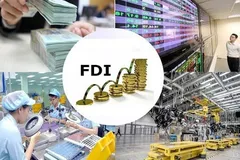
Hence, achieving a growth rate exceeding 5% should be viewed as a success. However, realizing this goal will require a synchronized approach involving several rapid solutions.
JOURNALIST: - Dr. Lâm, how do you assess the prospects for economic growth in the fourth quarter and the overall growth target for 2023?
Dr. NGUYỄN BÍCH LÂM: - Growth in the first nine months of 2023 has reached 4.24%. To achieve the full-year target of 6.5% set by the National Assembly, the fourth-quarter growth would need to reach a staggering 12.4%. Given the current global and domestic economic conditions, characterized by an export-driven growth strategy, this seems unattainable. The Ministry of Planning and Investment has proposed three growth scenarios.
In Scenario 1, if the GDP for the entire year reaches around 5%, the fourth quarter would need to reach approximately 7%. In Scenario 2, with a 5.5% GDP for the year, the fourth quarter's growth would need to be about 8.8%. In Scenario 3, with a 6% GDP for the year, the fourth quarter's growth would need to be about 10.6%.
Of these scenarios, which is the most suitable for this year? Looking at the supply side of the economy, the manufacturing industry has historically been the primary growth driver. However, there is some recovery, but it is precarious. In the first nine months, the industrial production index for the processing and manufacturing sector only increased by 0.2% compared to the same period last year. The industry's average inventory ratio stands at 85.3%, which is 8.9% higher than the same period in 2022. This indicates that the domestic market struggles to absorb the nation's manufactured goods.
In the past nine months, only February and August saw the Purchasing Managers' Index (PMI) exceed 50, with readings of 51.2 and 50.5, respectively. The other months all fell below the 50-point threshold. In August, PMI reached 50.5, but in September, it fell to 49.7, indicating a decline in output, new orders, purchasing activities, employment, and a fragile and unsustainable recovery in the manufacturing sector. Concerning exports, there haven't been many highlights in the last three months of 2023, leading to total export turnover being on par with the previous year, while domestic final consumption shows no signs of improvement.
In light of this, achieving a GDP growth rate of 5% or 5.5% for 2023 can be considered a success. Achieving this level of growth in 2023 would mean it's 2.1 times higher than the global growth rate, and 2.3 times higher if it reaches about 5.5%, all while keeping inflation under control and maintaining macroeconomic stability. However, given the current domestic and global economic situation, attaining 5% growth for the whole year in 2023 remains a formidable challenge.
- What steps should be taken to achieve the highest possible economic growth in the time remaining?
- With limited time left in 2023, the government must swiftly implement effective stimulus measures, instill positive sentiment, and foster confidence among domestic and international businesses and investors about the rapid and promising recovery of the economy. In my view, in the coming months, we should focus on three main sets of solutions: stimulating domestic consumption, boosting investments, and enhancing exports.
In the immediate term, stimulating consumption to increase purchasing power should be a priority. This can be achieved by offering promotions, reducing prices on consumer goods and services, lowering interest rates, decreasing personal income taxes, and expanding consumer loans. Additionally, debt restructuring and support for social security should be considered.
Reducing the prices of consumer goods can significantly impact spending patterns, stimulate final consumption, and increase the overall demand for consumer goods and services within the economy. The service sector plays a crucial role in growth, with the service producer price index rising by 7.34% over the same period last year in the first nine months.
The transport service index, in particular, increased by 19.34%, notably the air transport service price index rose by 99.79% compared to the previous year, leading some domestic tourists to opt for international travel due to more affordable airfares. This, in turn, has contributed to service imports and a dip in economic growth.
Moreover, the accommodation and food services index increased by 5.97%. Hence, businesses and service providers should streamline their costs to keep service prices in check and avoid raising prices during peak seasons. Domestic consumption remains sluggish, partly due to the lingering effects of the COVID-19 pandemic. Therefore, attracting international tourists to Vietnam and promoting domestic tourism to increase overall domestic consumption demand is essential.
In addition to boosting consumption, the government should focus on implementing investment stimulation measures to enhance the economy's production capacity and competitiveness. This includes investment in infrastructure, transportation systems, warehouses, and industrial park infrastructure. Priority should be given to projects that are near completion and have market prospects. Public investment disbursement is vital for economic growth, and addressing land and resource-related challenges and addressing delays in capital delivery and public investment disbursement is crucial.
In conclusion, swift and coordinated efforts are essential to boost economic growth in the time remaining in 2023.
- Thank you for your insights.




















